Introduction
The importance of physical activity and sedentary behaviour measurements in clinical and hospital settings has gained significant attention in recent years. As researchers and clinicians strive to better understand the impact of sedentary behavior and physical activity on health outcomes, accurate and reliable measurement tools become more crucial. This article will discuss various methods and technologies used to assess sedentary behavior and physical activity in these settings, aiming to provide a comprehensive guide for researchers and clinicians.
Sedentary behavior, characterized by prolonged periods of sitting or low-energy expenditure, has been associated with numerous negative health outcomes, including obesity, type 2 diabetes, cardiovascular disease, and certain types of cancer. Conversely, engaging in regular physical activity has been shown to improve both physical and mental health, reducing the risk of chronic diseases and promoting overall well-being. It is therefore essential for healthcare professionals to measure daily physical activity and sedentary time accurately to better understand their patients’ physical activity level and design appropriate interventions to improve health outcomes.
In this article, we will delve into various measurement tools and techniques, ranging from objective devices such as accelerometers and inclinometers to subjective methods like self-report questionnaires and activity diaries. Additionally, we will discuss the practical considerations for selecting the most appropriate measurement tool for your specific needs, whether you are a researcher designing a study or a clinician working with patients.
Furthermore, we will explore emerging technologies in the field of sedentary behaviour and physical activity measurement. These advancements, such as artificial intelligence and machine learning, have the potential to push the understanding of physical behaviour to the next level, providing real-time feedback and personalized interventions to optimize patient care.
We will also highlight the importance of interdisciplinary collaboration in advancing our understanding of physical activity and sedentary behavior. By bridging the gap between research and practice, researchers and clinicians can work together to build a strong evidence base for effective interventions.
As you navigate through this article, we invite you to explore our other resources on various topics related to physical activity and sedentary behavior measurements, including special populations, older adults, and children and adolescents. Our goal is to provide you with the most up-to-date information to help you make informed decisions when selecting measurement tools and technologies to better understand and promote physical activity and reduce sedentary behavior in clinical and hospital settings.
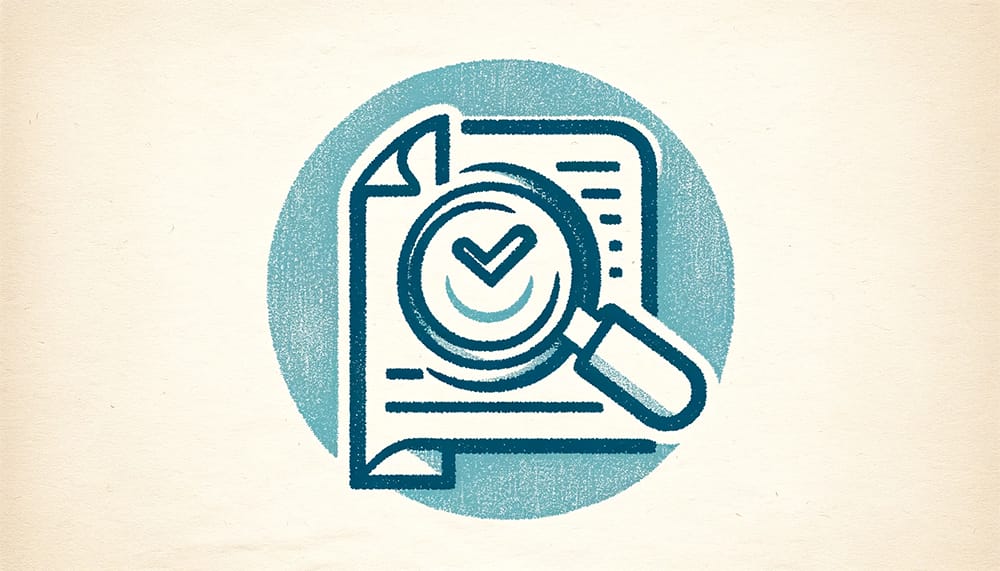
The Importance of Measuring Physical Activity and Sedentary Behaviour Measurements
Impact on Health Outcomes
The accurate measurement of physical activity and sedentary behavior is essential for understanding the effects of these behaviors on health outcomes. Prolonged sedentary behavior has been linked to various negative health effects, such as obesity, type 2 diabetes, cardiovascular diseases, and some types of cancer. On the other hand, engaging in regular physical activity can positively impact patient recovery and overall well-being, including reduced risk of chronic diseases, improved mental health, and enhanced quality of life.
Especially for older adults, it is crucial to assess their activity level to design appropriate interventions to maintain or improve their health status. By accurately measuring physical activity and sedentary behavior, healthcare professionals can better understand the relationships between these behaviors and various health outcomes, leading to the development of more effective interventions. For more information about older adults and activity measurements, visit our article on older adults’ activity and sedentary measurements.
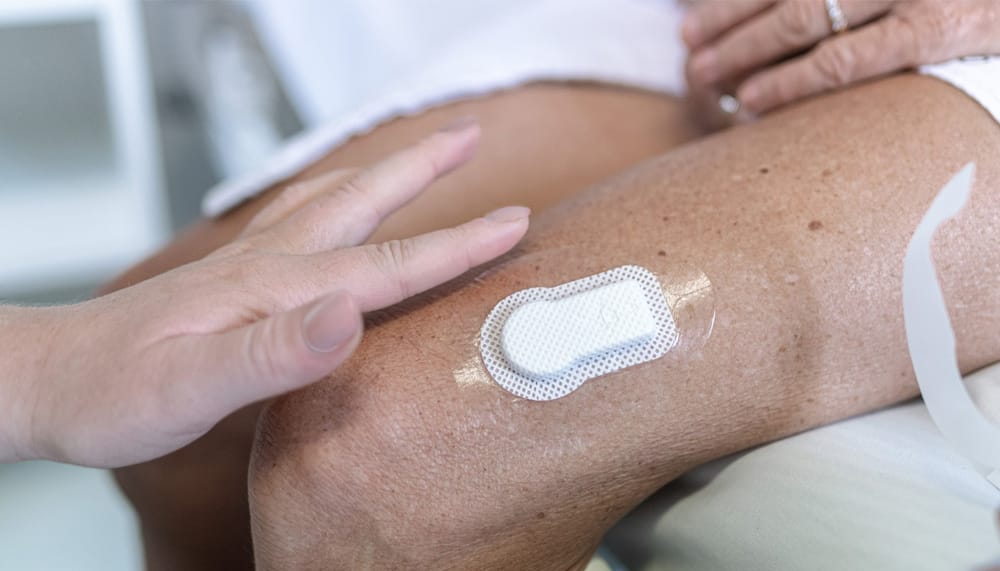
Monitoring and Evaluation in Clinical Settings
Accurate measurements of physical activity and sedentary behavior in clinical settings play a vital role in treatment planning and monitoring. Using reliable activity monitors allows healthcare professionals to develop personalized interventions and track progress over time. This not only helps clinicians optimize treatment plans but also empowers patients to take an active role in managing their health, ultimately leading to better health outcomes.
A systematic review and meta-analysis of interventions targeting physical activity and sedentary behavior can provide insights into the effectiveness of different approaches. By identifying the most effective strategies, clinicians can design tailored interventions to maximize patient engagement and adherence to treatment plans. To learn more about different measurement methods, check out our article on methods and tools for sedentary behavior and activity measurement.
Furthermore, measuring physical activity and sedentary behavior in clinical settings can help healthcare professionals identify at-risk populations, such as children and adolescents or special populations, who may require targeted interventions. Accurate measurements can also play a crucial role in evaluating the effectiveness of interventions in various contexts, such as occupational settings and clinical settings.
In conclusion, the importance of measuring physical activity and sedentary behavior in clinical and hospital settings cannot be overstated. Accurate measurements provide valuable insights into the impact of these behaviors on health outcomes and enable healthcare professionals to design and implement effective interventions. By prioritizing accurate and reliable measurement tools and technologies, researchers and clinicians can work together to improve patient care and promote a healthier, more active lifestyle.

Physical Activity Measurements in Clinical and Hospital Settings
Objective Measurement Tools
To assess physical activity levels in clinical and hospital settings, various objective measurement tools are available, each with its own advantages and limitations.
Accelerometers: These devices measure acceleration and can provide valuable insights into the intensity and duration of physical activity. They are widely used in research settings due to their ability to capture a wide range of activity patterns. However, they may be more expensive than other options and can underestimate certain activities like cycling or swimming. Learn more about accelerometers in our article on measuring physical activity with accelerometers.
- Accelerometers: These devices measure acceleration and can provide valuable insights into the intensity and duration of physical activity. They are widely used in research settings due to their ability to capture a wide range of activity patterns. However, they may be more expensive than other options and can underestimate certain activities like cycling or swimming. Learn more about accelerometers in our article on measuring physical activity with accelerometers.
- Pedometers: A low-cost alternative to accelerometers, pedometers measure steps taken and can help motivate individuals to increase physical activity. They are easy to use but may not accurately capture non-ambulatory activities or provide information on exercise intensity.
- Heart rate monitors: These devices assess exercise intensity by measuring heart rate during activity. They are useful for monitoring and adjusting individualized exercise programs but may be influenced by factors unrelated to physical activity, such as stress or caffeine consumption.
- Wearable fitness trackers: Increasingly popular in both research and clinical settings, fitness trackers integrate data from multiple sensors to provide a comprehensive overview of physical activity and sedentary behavior. They can be easily incorporated into clinical practice to help patients reduce sedentary time and monitor progress. However, accuracy and data reliability may vary between devices and brands.
Subjective Measurement Tools
Subjective measurement tools rely on self-reported information from patients to evaluate their level of physical activity.
- Self-report questionnaires: Widely used due to their low cost and ease of administration, self-report questionnaires provide valuable information on activity type, frequency, and duration. However, they are subject to recall bias and may not accurately capture all aspects of physical activity. Some examples include the International Physical Activity Questionnaire (IPAQ) and the Global Physical Activity Questionnaire (GPAQ).
- Activity diaries: These tools require patients to record their daily activities, offering insights into their experiences and allowing clinicians to assess adherence to exercise recommendations. While they can provide rich contextual information, activity diaries may be time-consuming and may not capture all activity if patients forget to record it.
- Direct observation: This method involves observing and recording physical activity as it occurs. Although time-consuming and labor-intensive, direct observation can provide valuable insights into activity patterns and behaviors, particularly in special populations or specific environments.
In conclusion, the choice of measurement tool depends on the specific goals and requirements of the clinical or hospital setting. A combination of objective and subjective tools can provide a comprehensive understanding of physical activity levels, helping healthcare professionals design targeted interventions to improve patient health and well-being. For more information, refer to our article on choosing the right measurement method.
Ultimately, accurate measurement of physical activity and sedentary behavior in clinical and hospital settings is crucial for monitoring patient progress, evaluating the effectiveness of interventions, and understanding the relationship between activity and health outcomes. By selecting the appropriate tools and methods, researchers and clinicians can help patients achieve better health outcomes, support behavior change, and promote a more active lifestyle.
For more insights into physical activity measurements in various populations, visit our articles on special populations, older adults, and children and adolescents.
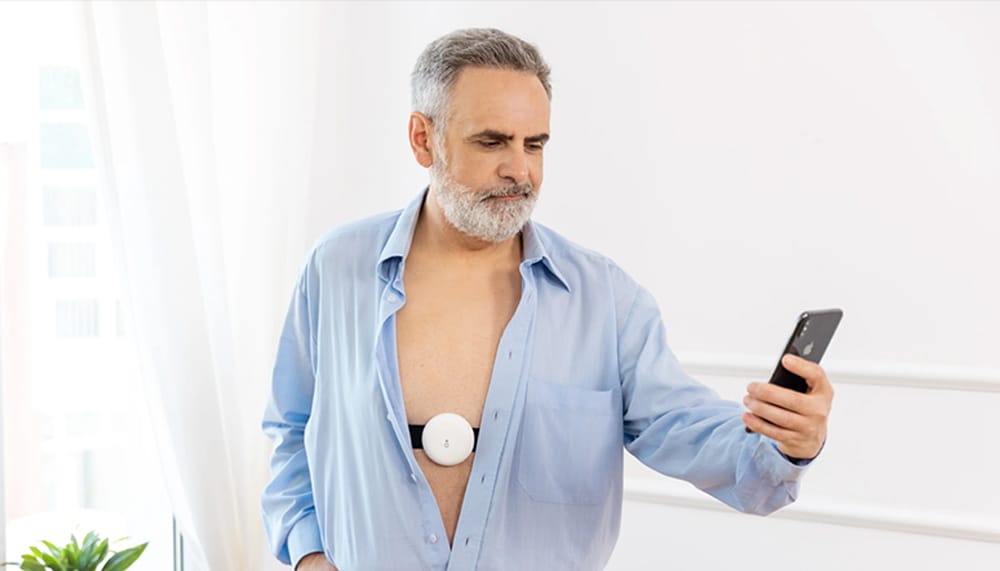
Sedentary Behavior Measurements in Clinical and Hospital Settings
Objective Measurement Tools
The accurate assessment of sedentary behavior is crucial for understanding its impact on health and developing effective interventions. In clinical and hospital settings, both objective and subjective tools can be employed to measure sedentary behavior.
Objective measurement tools provide quantifiable data on sedentary behavior. Some popular options include:
- Inclinometers: These devices detect posture changes and can differentiate between sitting, standing, and lying down. Inclinometers provide an accurate measure of the time spent in various postures.
- Pressure-sensitive mats: Placed on chairs or beds, these mats measure sitting or lying time by detecting pressure changes. They can be useful in hospital settings to monitor patients with mobility limitations.
- Wearable devices with sedentary behavior tracking features: Many fitness trackers and smartwatches now include features for tracking sedentary behavior, such as prolonged sitting time. These devices can help patients become more aware of their daily activity patterns and motivate them to reduce sedentary behaviors.
Objective Measurement Tools
Subjective tools rely on self-reporting and can provide valuable insights into the context and patterns of sedentary behavior. Some common subjective tools include:
- Self-report questionnaires: These questionnaires assess sedentary behavior patterns, including the type and duration of activities. While they may be prone to recall bias, self-report questionnaires can provide valuable information on the context of sedentary behaviors and help identify areas for intervention.
- Time-use diaries: Patients record their daily activities in these diaries, providing detailed information on sedentary behaviors, such as watching TV or using a computer. Time-use diaries can help clinicians understand the context and patterns of sedentary behavior, but they may be time-consuming for patients to complete.
- Direct observation: As the gold standard for sedentary behavior assessment, direct observation involves trained observers monitoring and recording patients’ behaviors. While this method is highly accurate, it can be time-consuming and may not be feasible in all clinical settings.
In conclusion, the effective measurement of sedentary behavior in clinical and hospital settings is essential for understanding the impact of physical inactivity on health and developing targeted interventions. Both objective and subjective tools have their advantages and limitations, and the choice of method depends on the specific needs of the clinical setting and patient population.
To learn more about sedentary behavior measurements and their implications, visit our articles on sedentary behavior and physical activity measurements, health implications of sedentary behavior, and methods and tools for sedentary behavior and activity measurement.
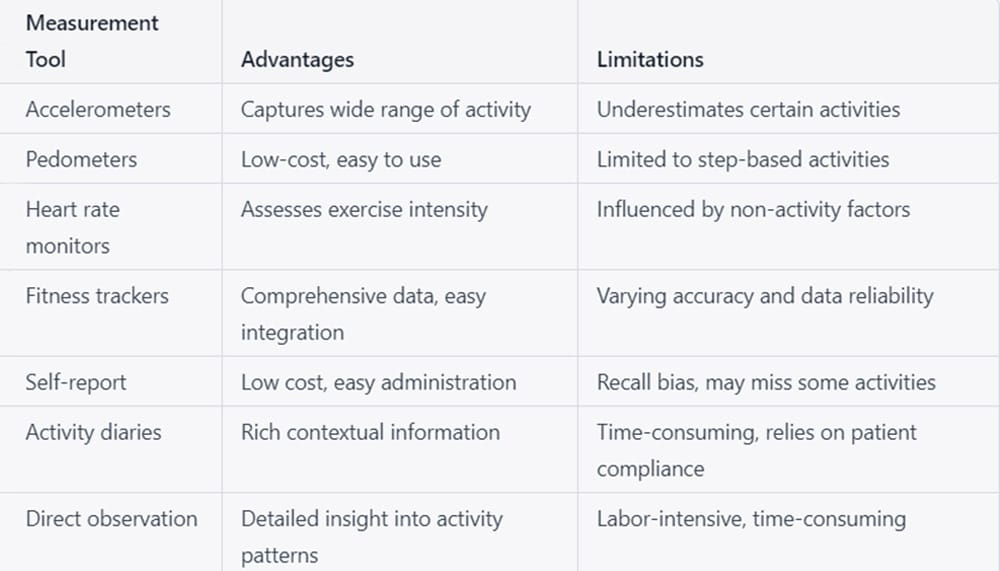
Selecting the Right Measurement Tools for Your Needs
Choosing the right measurement tools for sedentary behavior and physical activity can be challenging. The best choice depends on the specific objectives and requirements of researchers and clinicians. This article outlines the key considerations for selecting appropriate measurement tools.
Considerations for Researchers
When selecting measurement tools for research purposes, consider the following:
- Study objectives and research questions: Identify the specific aims of your study and the research questions you want to address. This will help you determine the most appropriate tools for measuring sedentary behavior and physical activity.
- Sample size and participant characteristics: The size of your study and the characteristics of your participants (e.g., age, health status, occupation) will influence the choice of measurement tools. Some tools may be more suitable for certain populations, while others may require a larger sample size for meaningful results.
- Budget and resource constraints: Consider the cost of the measurement tools and the resources needed for their implementation. Some tools, such as accelerometers, may be more expensive than others, like pedometers, but may provide more accurate data.
- Data analysis requirements: Different tools may produce different types of data. Ensure that you have the necessary expertise and software to analyze and interpret the data generated by your chosen measurement tools.
Considerations for Clinicians
When selecting measurement tools for clinical use, consider the following:
- Patient population and individual needs: The characteristics of your patient population and their individual needs should guide your choice of measurement tools. For instance, wearable devices may be more suitable for younger patients, while older adults may prefer simpler tools like pedometers.
- Integration with existing clinical workflows: Choose measurement tools that can be easily integrated into your current workflows and electronic health record systems. This will streamline data collection and analysis, making it easier for clinicians to monitor patients’ progress.
- Staff training and support: Select tools that come with adequate training and support to ensure that your staff can use them effectively. This may include user manuals, online resources, or in-person training sessions.
- Cost-effectiveness and return on investment: Consider the long-term value of the measurement tools in terms of improving patient outcomes, reducing healthcare costs, and enhancing your clinical practice. Weigh the initial investment against the potential benefits to determine the most cost-effective solution.
In conclusion, selecting the right measurement tools for your needs is crucial for accurately assessing sedentary behavior and physical activity. Carefully consider your objectives, resources, and target population to make an informed decision. For more guidance on choosing the appropriate measurement tools, visit our article on choosing the right measurement method for research and clinical settings, and explore our resources on methods and tools for sedentary behavior and activity measurement.
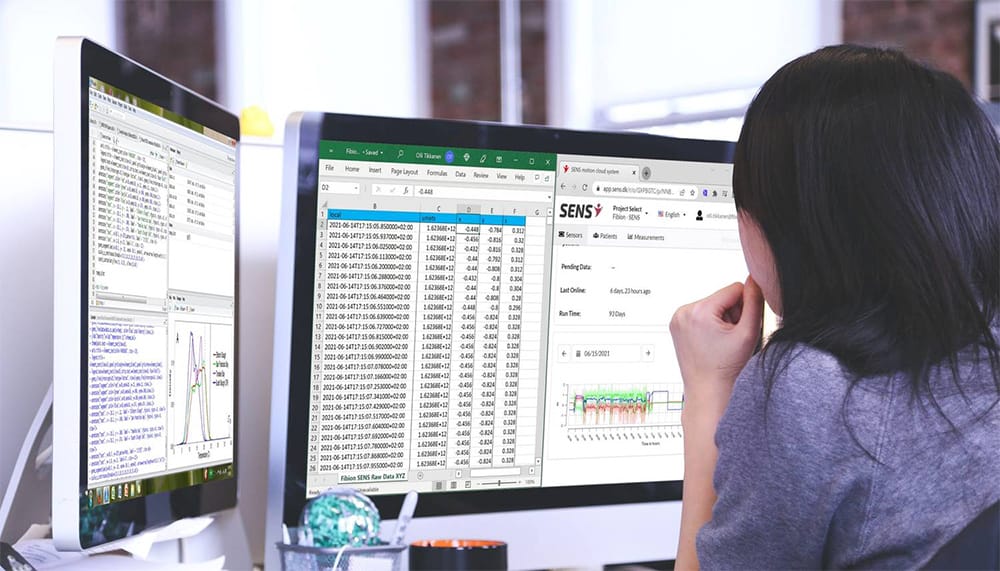
The Future of Physical Activity and Sedentary Behavior Measurements
The future of measuring physical activity and sedentary behavior promises exciting developments driven by technological advances and interdisciplinary collaboration. This article explores the innovations shaping the future of activity measurement and the opportunities they present.
Technological Advances
Advancements in technology will play a significant role in improving the accuracy and effectiveness of physical activity and sedentary behavior measurements. Key developments include:
- New sensor technologies for improved accuracy: Emerging sensor technologies, such as nanosensors and biocompatible materials, will enable more precise and unobtrusive measurement of activity patterns, providing a better understanding of physical activity in older populations and behavior during and after hospitalization.
- Integration of artificial intelligence (AI) and machine learning: AI and machine learning algorithms will enhance the analysis and interpretation of physical activity data, helping to identify trends, predict outcomes, and tailor interventions to individual needs.
- Real-time feedback and personalized interventions: Wearable devices and smartphone applications will increasingly provide real-time feedback on activity intensity, helping individuals monitor their progress against physical activity guidelines and adjust their behaviors accordingly.
Interdisciplinary Collaboration
Collaboration between researchers and clinicians will be crucial in driving the future of physical activity and sedentary behavior measurements. Some of the opportunities include:
- Opportunities for collaboration between researchers and clinicians: Cross-disciplinary partnerships will allow researchers to develop and validate new measurement tools and methodologies, while clinicians will benefit from access to cutting-edge technologies and evidence-based interventions.
- Bridging the gap between research and practice: Stronger connections between research and clinical practice will ensure that guidelines on physical activity and sedentary behavior are informed by the latest evidence and translated effectively into real-world interventions.
- Building a strong evidence base for interventions: By working together, researchers and clinicians can build a robust evidence base to inform the development of effective and cost-efficient interventions that improve population health and reduce the burden of physical inactivity.
In conclusion, the future of physical activity and sedentary behavior measurements will be shaped by technological innovations and interdisciplinary collaboration. These developments will enable more accurate and personalized assessment of activity levels, fostering the creation of effective interventions to promote healthier lifestyles. To stay informed about the latest developments in activity measurement, explore our articles on emerging technologies and methods and tools for sedentary behavior and activity measurement.

Conclusion
As we reach the end of our exploration into the measurement of sedentary behavior and physical activity, it is essential to appreciate the significance of accurate and reliable monitoring. Understanding the time spent in sedentary positions and intensity of physical activity is crucial for researchers and clinicians, as it informs interventions and guides individuals towards healthier lifestyles.
The growing need for precise physical activity monitoring has led to the development of various measurement tools and methods, each with its unique advantages and limitations. Selecting the most suitable tool depends on factors like study objectives, research questions, sample size, participant characteristics, and budget. A careful evaluation of these factors will enable researchers and clinicians to make informed decisions in their quest to promote and maintain regular physical activity.
Advancements in technology, particularly in sensor development, artificial intelligence, and machine learning, are paving the way for more accurate, personalized, and real-time monitoring of physical activity intensity. This evolution will undoubtedly contribute to the effectiveness of interventions and improve our understanding of the effect of physical inactivity on overall health.
Interdisciplinary collaboration is vital in bridging the gap between research and clinical practice, ensuring that the most recent findings are translated into real-world applications. This synergy will enable the development of evidence-based interventions targeting sedentary behavior and promoting light, moderate and vigorous physical activity across diverse populations.
In conclusion, accurate measurement of sedentary behavior and physical activity plays a critical role in addressing the global challenge of physical inactivity. As technology continues to advance and interdisciplinary collaboration strengthens, the future of activity measurement is bright, promising improved health outcomes for individuals worldwide.
To deepen your understanding of sedentary behavior and physical activity measurements, explore our articles on topics like accelerometer-based measurements, clinical setting applications, and methods and tools for sedentary behavior and activity measurement. Our goal is to support researchers and clinicians in their pursuit of healthier and more active lifestyles for all.











